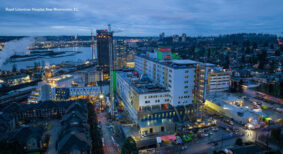The Federation of Canadian Municipalities has estimated Canada needs about $123 billion to bring crumbling public infrastructure up to acceptable levels and an additional $115 billion to meet growing demand. Canada typically spends 3 per cent of GDP annually on public infrastructure and a growing portion of this is under the control of municipal government.
Our very way of life depends on our transportation systems, water and wastewater facilities, recreation centres, schools, hospitals, jails and other public services. Much discussion has taken place regarding the raising of funds to provide these projects, but increasingly the focus is moving to whether the public is getting good value for these huge capital expenditures.
Traditionally most public projects started with the hiring of an architect or an engineer, plans were drawn, tenders invited and the low bid accepted. It has become the general rule that projects go over budget and frequently fail to meet the expectations for their performance.
Problems can usually be traced back to the outset of the project in question. Even the hiring of the architect or engineer is frequently part of the problem. Any public project should always start with a clear statement of the goals and objectives before anyone puts pen to paper. Recognition that there are many ways to achieve goals and objectives is essential before plans are drawn.
A second essential part of a project is documenting the risks involved in providing the facilities. This means considering not just the planning of the capital project but also the ongoing operation. Frequently the costs of 25 years of operation will exceed the capital cost of the infrastructure.
Even when a specific project is determined as the solution to the goals and objectives, it needs to be understood that most of the potential for innovation and cost savings is not at the construction stage, but rather at the initial design. The lowest bid for the wrong project is still poor value for money. An architect or an engineer is usually hired by a competitive process based on fees and experience, but once hired that professional designs the project without any competitive forces being in place. Frequently designs are overly conservative, may fail to meet the goals and objectives and the end result fails to meet the initial requirements.
It was for this reason that many public agencies moved to a design/build model where the designer and the builder were all on the same team and the owner received three proposals that involved not only a competition in construction, but also a competition in design. Further to that, it then became apparent that there should also be a competition around the operation and maintenance and the finance. So was borne the public-private partnership where all of design, build, operation, maintenance and finance became part of the competition.
Innovation and creativity is a key ingredient in the successful delivery of public projects. However, it is important to understand Canada as a country. Generally the focus of attention is the big projects ($100 million plus) in the large urban centres. Canada is also a country of smaller, often rural communities, many remote from large urban centres. What works for a $300 million hospital in Vancouver does not necessarily work for a $10 million wastewater treatment plant in rural Alberta.
There is no one preferred “cookie cutter” solution to delivering public infrastructure. Each project is a unique opportunity dependent on the location, type of infrastructure and community values. Public-private partnerships will never be a solution to every project, in fact they will likely only represent good value for money in a very small number of cases. There is however a preferred process to initiating a project, and it is not hiring an architect or an engineer to start drawing plans, or hiring a lawyer to draft legal agreements. Every project must have a business plan, even if that business plan is only 10 pages long. The plan must clearly identify the opportunities and the pitfalls.
Examples of smaller innovative projects are everywhere, but because of their size gather little attention. The North Kamloops Library ($5 million) became part of a six storey apartment building through a design/build/develop process. $15 million of innovative improvements to the base lands in a complex area around the CN Tower in Toronto were accomplished on budget through a design/build process. There is now significant use of government business enterprises to maintain public ownership of assets while achieving the best parts of a public-private partnership without the negative downside.
The challenge for Canada is not just finding the money to pay for all the required public infrastructure improvements, but also learning to deliver those projects in a way that provides better value for money, greater certainty over price, and guarantees that the required performance will be met. In doing so, we all need to understand that Canada is as much a country of smaller communities as it is of large cities.
Jonathan R. Huggett, P.Eng (BC, Alberta, Ontario), is principal of J.R. Huggett Company. He is an infrastructure specialist with more than 35 years of experience.










